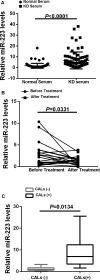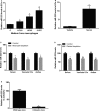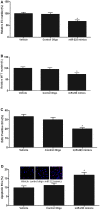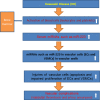Bone Marrow-Derived MicroRNA-223 Works as an Endocrine Genetic Signal in Vascular Endothelial Cells and Participates in Vascular Injury From Kawasaki Disease
- PMID: 28196816
- PMCID: PMC5523776
- DOI: 10.1161/JAHA.116.004878
Bone Marrow-Derived MicroRNA-223 Works as an Endocrine Genetic Signal in Vascular Endothelial Cells and Participates in Vascular Injury From Kawasaki Disease
Abstract
Background: Kawasaki disease (KD) is now the most common cause of acquired cardiac disease in children due to permanent coronary artery damage with unknown etiology. The study sought to determine the role of blood microRNA miR-223 in KD and KD-induced injuries in vascular endothelial cells (ECs) as well as the mechanisms involved.
Methods and results: MicroRNA profiles in serum from patients with KD and from healthy controls were assessed by microarray analysis. We noted that multiple serum microRNAs were aberrantly expressed in KD, among them miR-223, which was the most upregulated abundant serum microRNA. We found that bone marrow-derived blood cells (leukocytes and platelets) were able to secrete miR-223 into serum. Vascular ECs had no endogenous miR-223; however, the blood cell-secreted serum miR-223 could enter into the vascular ECs in the vascular walls. The exogenous miR-223 had strong biological effects on EC functions via its target genes such as IGF1R. Interestingly, KD-induced EC injuries were related to increased miR-223 because they were inhibited by miR-223 knockdown. Finally, these observations were verified using miR-223 knockout mice and the chimeric mice generated by transplantation of bone marrow from miR-223 knockout mice into wild-type mice.
Conclusions: In KD patients, the levels of blood cell-derived miR-223 in ECs are significantly increased. The increased miR-223 in ECs could work as a novel endocrine genetic signal and participate in vascular injury of KD. MiR-223 may provide a novel mechanism and a new therapeutic target for vascular complication of KD.
Keywords: Kawasaki disease; blood cells; endothelial cells; miR‐223; microRNA; vascular inflammation.
© 2017 The Authors. Published on behalf of the American Heart Association, Inc., by Wiley Blackwell.
Figures







Similar articles
-
Reduced Platelet miR-223 Induction in Kawasaki Disease Leads to Severe Coronary Artery Pathology Through a miR-223/PDGFRβ Vascular Smooth Muscle Cell Axis.Circ Res. 2020 Sep 11;127(7):855-873. doi: 10.1161/CIRCRESAHA.120.316951. Epub 2020 Jun 29. Circ Res. 2020. PMID: 32597702 Free PMC article.
-
MicroRNA-197-3p mediates damage to human coronary artery endothelial cells via targeting TIMP3 in Kawasaki disease.Mol Cell Biochem. 2021 Dec;476(12):4245-4263. doi: 10.1007/s11010-021-04238-7. Epub 2021 Aug 5. Mol Cell Biochem. 2021. PMID: 34351574
-
An Endocrine Genetic Signal Between Blood Cells and Vascular Smooth Muscle Cells: Role of MicroRNA-223 in Smooth Muscle Function and Atherogenesis.J Am Coll Cardiol. 2015 Jun 16;65(23):2526-37. doi: 10.1016/j.jacc.2015.03.570. J Am Coll Cardiol. 2015. PMID: 26065992 Free PMC article.
-
MicroRNA-155 in the pathogenesis of atherosclerosis: a conflicting role?Heart Lung Circ. 2013 Oct;22(10):811-8. doi: 10.1016/j.hlc.2013.05.651. Epub 2013 Jul 1. Heart Lung Circ. 2013. PMID: 23827206 Review.
-
MicroRNA-126, -145, and -155: a therapeutic triad in atherosclerosis?Arterioscler Thromb Vasc Biol. 2013 Mar;33(3):449-54. doi: 10.1161/ATVBAHA.112.300279. Epub 2013 Jan 16. Arterioscler Thromb Vasc Biol. 2013. PMID: 23324496 Review.
Cited by
-
miR‑186, a serum microRNA, induces endothelial cell apoptosis by targeting SMAD6 in Kawasaki disease.Int J Mol Med. 2018 Apr;41(4):1899-1908. doi: 10.3892/ijmm.2018.3397. Epub 2018 Jan 18. Int J Mol Med. 2018. PMID: 29344637 Free PMC article.
-
Lack of association between miR-218 rs11134527 A>G and Kawasaki disease susceptibility.Biosci Rep. 2018 May 22;38(3):BSR20180367. doi: 10.1042/BSR20180367. Print 2018 May 29. Biosci Rep. 2018. PMID: 29717030 Free PMC article.
-
miR-223-3p reduces high glucose and high fat-induced endothelial cell injury in diabetic mice by regulating NLRP3 expression.Exp Ther Med. 2020 Aug;20(2):1514-1520. doi: 10.3892/etm.2020.8864. Epub 2020 Jun 10. Exp Ther Med. 2020. PMID: 32765674 Free PMC article.
-
Molecular mechanisms of endothelial dysfunction in Kawasaki-disease-associated vasculitis.Front Cardiovasc Med. 2022 Aug 8;9:981010. doi: 10.3389/fcvm.2022.981010. eCollection 2022. Front Cardiovasc Med. 2022. PMID: 36003919 Free PMC article. Review.
-
Early pathological characterization of murine dissecting abdominal aortic aneurysms.APL Bioeng. 2018 Dec 20;2(4):046106. doi: 10.1063/1.5053708. eCollection 2018 Dec. APL Bioeng. 2018. PMID: 31069328 Free PMC article.
References
-
- Newburger JW, Takahashi M, Burns JC. Kawasaki disease. J Am Coll Cardiol. 2016;67:1738–1749. - PubMed
-
- Chen KY, Curtis N, Dahdah N, Kowalski R, Cheung M, Burgner DP, Kowalski R. Kawasaki disease and cardiovascular risk: a comprehensive review of subclinical vascular changes in the longer term. Acta Paediatr. 2016;105:752–761. - PubMed
Publication types
MeSH terms
Substances
Grants and funding
LinkOut - more resources
Full Text Sources
Other Literature Sources
Medical

